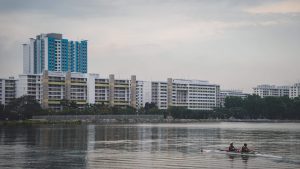My name is Robert, and I once lost my home.
Some still call me a walking cautionary tale, a living example of what not to do when times are good. If you’re here looking for a “how-to” guide on buying your first home, I’m basically the least ideal person to ask.
After all, I was once an affluent businessman.
These days, life is pretty good. I’m 62, and I work as a property developer. I’m also semi-retired, living in a 4-room HDB flat in Pasir Ris with my wife. We have three children, and luckily for us, they’ve all grown up and are now supporting themselves.
As far as middle class families, we’re quite typical.
We’re not rich, but we’re comfortable and happy. But it wasn’t always like this.
If you’re willing to listen, you’ll thank me soon enough for telling you my story.
In the late 80s, I made friends with some successful property developers and discovered that I could finally be my own boss. Thanks to them, it didn’t take me long to open my own construction company. This was in 1991.
My company broke even in six months. By the end of the first year, I had made close to S$300,000, with many more construction projects lined up.
Perhaps it was my entrepreneurial drive. Perhaps it was just luck. Whatever it was, money was rolling in. My wife was even able to quit her job as a banker to take care of the children.
At the peak of my career, I drove a Mercedes Benz, and I took my family on long holidays every year. In 1993, we moved to a semi-detached house in Kovan that I bought for S$1 million. I thought that I had finally attained the Singaporean dream. I owned a landed property, and had an abundance of other material possessions.
It didn’t seem to matter that we weren’t saving. It felt like I could always make enough, and it did not occur to me that my income could fluctuate, or that our circumstances could change.

Back then, there were no limits on how much of my income could go towards servicing my loans.
And then came 1997. The year of the Asian Financial Crisis.
Even before the crisis hit, we were already spending beyond my income. While I had already completed numerous property development projects, collecting payment from clients had become difficult. When the crisis hit, the owners of these properties went bankrupt, and these overdue payments turned into bad debts.
We had to exit the business. In 1999, I sold our home to pay off our creditors.
We were left with almost nothing, and I had only myself to blame.
With limited CPF and cash savings, we could not afford to buy another house. I had no choice but to move my family back to my parents’ home, a three-room HDB flat in Toa Payoh.
It’s not how much you make, it’s how much you spend that will define your life
Arguments and fights over money began, straining my marriage in the process. As much as I wanted to quit, I knew I couldn’t. A few months later, I found a job in another construction company as a project manager.
Times were still tough and we were barely making ends meet, but I promised to move my family out of that single bedroom to a home that we could call our own again.
Eventually, in 2001, after saving for a year and with some help from my parents, we moved out to a resale flat in Pasir Ris. Today, this is where we live.

I would not have bought such a large house. I know for sure we would have been just as happy living in a smaller place, and emergency funds would have taken priority over a huge monthly mortgage.
Instead of spending more than 50% of my income on loans, I would have left a larger income buffer so that, even in the event of a drastic change of circumstance such as a financial crisis, our mortgage could still be serviced.
Yet I also understand that hindsight is always 20/20, and life is unpredictable.
Fortunately, there are now regulations such as the Total Debt Servicing Ratio (TDSR) and the Mortgage Servicing Ratio (MSR). I know it sounds boring, but stay with me.
The TDSR limits the amount you can spend on mortgage loan monthly repayments to 60% of your gross monthly income less any outstanding debt repayment you have. If you are buying a HDB flat, the MSR limits the proportion of your monthly mortgage repayments to a maximum of 30% of your gross monthly income.
These regulations were introduced in 2013, and basically limit the amount you can borrow for a house loan, keeping them always in proportion to your income. In 1991, this didn’t exist.
At the same time, always also consider your personal circumstances when buying a home. These schemes can stop you from over-committing to a home, but you still have to plan for unexpected changes in income.
In particular, plan for a sufficient monthly cash buffer to service your loans in the event that your income is reduced or lost. While using CPF to finance a mortgage loan is a relatively straightforward process, homeowners need to be aware that there are CPF Valuation and Withdrawal Limits (VL and WL), which determine the maximum amount of Ordinary Account (OA) savings you can use to buy a property.
Once you hit the WL, you won’t be able to use your CPF to finance your loan. You will have to use cash instead.
This is especially pertinent if your monthly income fluctuates or if, like me, you’re running a business.
Finally, try not to lose sight of why you’re buying a home in the first place. At the end of the day, your home isn’t about the tangibles. It’s not about the physical space and the size of it, but about the people living in it.
So, if I could leave you with one piece of advice, it would be this:
It’s not how much you make, it’s how much you spend that will define your life. Even if you’re making a million a year, you’re still broke if you spend 2 million!
Sincerely,
Robert Wong
—
Did you know that CPF can be used for housing but there are certain limits to how much we can use so as to help us set aside more CPF for our retirement? Find out more about how your home loans can be affected by the Total Debt Servicing Ratio (TDSR) and Mortgage Service Ratio (MSR) here. Learn more about CPF Housing Withdrawal Limits when buying an HDB flat (with a remaining lease of at least 60 years) here.
This story is sponsored by the Central Provident Fund Board.






